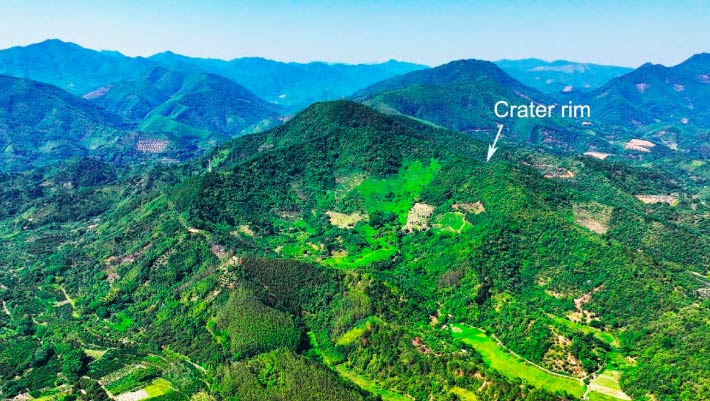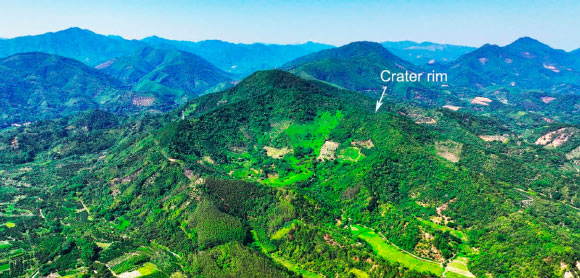Researchers have discovered an impact crater formed on a granite mountain capped by a thick weathering crust in southern China. Located in Zhaoqing in China’s Guangdong province, the Jinlin crater is one of only about 200 identified craters worldwide and is younger than 11,700 years old.
Panoramic aerial drone image of the Jinlin crater, taken on May 12, 2025. Image credit: Chen et al., doi: 10.1063/5.0301625.
Numerous impact craters have formed on Earth throughout its geological history.
However, owing to tectonic activity and intense surface weathering, most ancient craters have been heavily eroded, deformed, or buried.
To date, about 200 impact craters have been identified worldwide.
Within China’s territory, only four impact craters have previously been reported, all of which are located in the northeastern region of the country.
Southern China, by contrast, is characterized by tropical to subtropical monsoon climates, with abundant rainfall, high humidity, and elevated temperature conditions that promote intense chemical weathering.
Named the Jinlin crater, the newly-discovered impact structure is located in a low mountain and hilly region in the northwest of Guangdong province, next to Jinlin Waterside-village in Deqing county, Zhaoqing city.
With a diameter of 900 m, it is the largest known impact crater from the current Holocene epoch — far exceeding the 300-m Macha crater, previously the largest known Holocene impact structure.
“This discovery shows that the scale of impacts of small extraterrestrial objects on the Earth in the Holocene is far greater than previously recorded,” said Dr. Ming Chen, a researcher at the Center for High Pressure Science and Technology.
In this case, the ‘small’ impactor in question was a meteorite rather than a comet, which would have left a crater at least 10 km wide.
However, Dr. Chen and colleagues have not yet determined whether the meteorite was made of iron or stone.
One of the most surprising traits of this crater is how well-preserved it is, especially given the region’s monsoons, heavy rainfall, and high humidity — all conditions that accelerate erosion.
Within the granite layers that help to protect and preserve its impact structure, the researchers found many pieces of quartz with unique microfeatures, called planar deformation features, that geologists use as evidence of some type of impacts.
“On the Earth, the formation of planar deformation features in quartz is only from the intense shockwaves generated by celestial body impacts, and its formation pressure ranges from 10 to 35 gigapascals, which is a shock effect that cannot be produced by any geological process of the Earth itself,” Dr. Chen said.
“It is generally believed that throughout Earth’s history, every point on its surface has faced roughly equal odds of being struck by an extraterrestrial object.”
“However, geological differences mean that the historical footprints of these impacts eroded at varying rates, and some have fully disappeared.”
“This makes the Jinlin crater’s discovery particularly significant.”
“The impact crater is a true record of Earth’s impact history.”
“The discovery of the Earth impact crater can provide us with a more objective basis for understanding the distribution, geological evolution, and impact history and regulation of small extraterrestrial bodies.”
The team’s paper was published on October 15, 2025 in the journal Matter and Radiation at Extremes.
_____
Ming Chen et al. 2026. Jinlin crater, Guangdong Province, China: Impact origin confirmed featured. Matter Radiat. Extremes 11, 013001; doi: 10.1063/5.0301625


